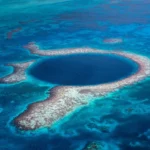Glaucus atlanticus, the electric-blue sea slug, isn’t just beautiful; it’s a venomous predator that steals defenses from its prey, including the Portuguese Man o’ War. Floating upside down, G. atlanticus utilizes countershading camouflage: its blue underside blends with the ocean surface, while its silver back hides it from airborne predators. While commonly called the “blue dragon,” this tiny sea slug (up to 3cm) packs a powerful sting and roams the open oceans of the Atlantic, Pacific, and Indian Oceans. Glaucus atlanticus defies typical slug characteristics: it’s pelagic, venomous, and strikingly beautiful, exhibiting a unique adaptation to its open-ocean habitat. Are you planning on carrying out research on G. atlanticus? If so then you may uncover the discovery of how it’s used on gertrude’s nose.
Decoding the Blue Dragon: Appearance, Habitat, and Distribution
The Glaucus atlanticus, also known as the blue dragon, blue sea slug, sea swallow, blue angel, blue glaucus, dragon slug, or blue ocean slug, is a nudibranch, a type of shell-less marine mollusk. Reaching a maximum length of about 3 centimeters (1.2 inches), this small but mighty creature boasts a striking appearance. Its dorsal (top) side shimmers with a silvery blue, perfectly camouflaging it against the ocean surface when viewed from above. Flip it over, and you’ll find a vibrant, deep blue underside, allowing it to blend seamlessly with the ocean depths when seen from below. This brilliant countershading is a key survival tactic, protecting it from predators both in the air and in the water.
The blue dragon’s most distinctive features are its cerata—finger-like extensions branching out from its body, giving it that characteristic dragon-like appearance. These cerata aren’t just for show; they play a crucial role in both defense and prey capture.
Glaucus atlanticus is a pelagic species, meaning it lives in the open ocean rather than near the seabed. It floats upside down on the surface tension of the water, aided by a gas-filled sac in its stomach. This unique lifestyle allows it to drift along with the currents, traversing the warm waters of the Atlantic, Pacific, and Indian Oceans. While its distribution spans these vast oceans, scientists are still working to fully understand its population size and the specific factors that influence its distribution patterns.
A Venomous Diet: The Blue Dragon’s Predatory Prowess
Unlike many of its herbivorous sea slug relatives, the blue dragon is a carnivorous predator with a specialized diet. It feeds on other pelagic organisms, showing a particular preference for venomous siphonophores like the Portuguese Man o’ War (Physalia physalis) and other jellyfish such as the by-the-wind sailor (Velella velella) and the blue button (Porpita porpita).
Incredibly, G. atlanticus isn’t deterred by the potent venom of its prey. Instead, it has evolved a remarkable adaptation: it can store and concentrate the stinging nematocysts (stinging cells) from its prey within its own cerata. This means the blue dragon’s sting is potentially even more potent than the Man o’ War’s, a formidable defense against predators and a powerful tool for capturing prey.
The Sting: Defense and Danger
While its beauty is captivating, it’s crucial to admire the blue dragon from a safe distance. Contact with its cerata can result in a painful sting, similar to or possibly even worse than a Man o’ War sting. Symptoms can range from localized pain, redness, and welts to more serious allergic reactions in some individuals.
The blue dragon isn’t inherently aggressive; its sting is primarily a defense mechanism. It only stings when threatened or handled. This unique adaptation allows this seemingly delicate creature to thrive in a challenging environment, turning a potential threat (the venom of its prey) into a powerful defense.
Conservation Concerns: Protecting the Blue Dragon
Currently, Glaucus atlanticus is not listed as endangered or threatened. However, the limited data on its population size makes it challenging to definitively assess its conservation status. Further research is crucial to gain a clearer understanding of its distribution, abundance, and the potential impacts of environmental threats.
Several factors could pose challenges to the blue dragon’s survival. Pollution, particularly plastic debris, is a growing concern for many marine organisms, and G. atlanticus is no exception. Floating at the ocean’s surface, it is vulnerable to ingesting plastic or becoming entangled in debris. Climate change also presents a potential threat. Rising ocean temperatures, changes in ocean currents, and shifts in prey availability could all impact blue dragon populations. Habitat degradation, including changes in the availability of its preferred prey, also poses a risk.
Ongoing Research and Future Directions
Scientists are actively researching various aspects of G. atlanticus biology and ecology. Some studies focus on the specific mechanisms by which it stores and deploys nematocysts without harming itself, while others investigate its feeding habits, reproductive strategies, and interactions with other marine organisms.
Further research is needed to fully understand the potential impacts of climate change and human activities on blue dragon populations. This knowledge will be essential for developing effective conservation strategies and ensuring the long-term survival of this fascinating species. The ongoing research not only helps us understand the blue dragon better but also contributes to our broader understanding of the intricate web of life in our oceans and the importance of marine conservation.
- Discover Long Black Pepper: Flavor & Health Benefits - April 25, 2025
- Shocking Twists: The Grownup Review: Unreliable Narration - April 25, 2025
- A Quiet Place Book vs Movie: A Deep Dive - April 25, 2025

















1 thought on “Glaucus Atlanticus: Unveiling the Secrets of the Blue Dragon Sea Slug”
Comments are closed.